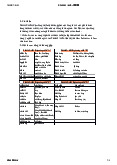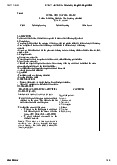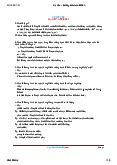







Preview text:
53 Reading the News 1 UNIT 5 Environmentalism 35(5($',1*7$6.6
+DYH\RXHYHUXVHGDQ\HQYLURQPHQWDOO\IULHQGO\SURGXFWV"&LUFOHWKHSURGXFWV WKDW\RXXVH
paper straw reusable water bottle tote bag wooden toothbrush biodegradable trash bag
:KLFKSURGXFWVDUHYLUDOLQ\RXUFRXQWU\"'LVFXVV\RXUDQVZHUZLWKDSDUWQHU
:KDWLVHQYLURQPHQWDOSHUIRUPDQFH"'LVFXVVZLWKDSDUWQHU 5($',1*)2&86
)RFXVRQWKHQHZVSDSHU23326,1*9,(:6
$UWLFOHV RIWHQ JLYH ERWK VLGHV RI D VWRU\ 6RPHWLPHV WKH ZULWHU RIIHUV D EDODQFHG
perspective, or argues the case for one particular side. Whichever focus they use, an
argument must be supported, either by evidence or by a quote from someone who knows
DORWDERXWWKHVXEMHFW
5HDGWKHIROORZLQJDUJXPHQWGHVFULSWRUV0DWFKHDFKDUJXPHQW±ZLWKLWV
FRXQWHUDUJXPHQWDF
5HXVDEOHWRWHEDJLV
D,WWXUQVRXWWKDWPRUHPDWHULDOVDUHXVHGWRPDNH environmentally friendly
those stuff once people buy more than necessary
'XIRHEX\V³JUHHQ´VWXIIWRVDYH
E7KHDXWKRUVD\V³7KHQRWLRQRIVKRSSLQJIRU the environment salvation turns my stomach”
3HRSOH EX\ PRUH VWXII EHFDXVH F &RPSDUHGWRSODVWLF EDJLW XVHVPXFK PRUH
they’re environmentally friendly resources to be made
1RZVFDQWKHDUWLFOHDQGPDWFKWKHDERYHGHVFULSWRUVZLWKWKHLUSDUDJUDSKQXPEHUV LQWKHDUWLFOH BBBBBBB BBBBBBB BBBBBBB DBBBBBBB EBBBBBBB FBBBBBBB
:KLFK LV WKH EHVW GHVFULSWLRQ RI WKH DUJXPHQW LQ WKH DUWLFOH" ,V LW VOLJKWO\ ELDVHG
against environmentally responsible products, towards environmentally responsible
products or, on the whole, neutral? 54 Reading the News 1
Do ‘environmentally responsible’ Products Help The Planet?
Or Do They Just Get Us to Buy More Stuff?
By Stephanie Parker October 22, 2019
$EEH\ 'XIRH D \HDUROG ZHE
SURGXFHU LQ 1HZ -HUVH\ FDUHV DERXW WKH
environment. On the weekends, she and
her partner go on beach hikes and pick up
trash. She buys in bulk to reduce packaging
waste and tries to recycle as much as she
can. She is also a fan of “green” products
like metal straws, tote bags and reusable
water bottles, and buys her clothes and
shoes from companies that claim to make
DGGLWLRQDO ZDVWH EHFDXVH RI WKHVH NQRFN
environmentally and socially conscious
RIIV,WZDVQ¶WRXUGLUHFWZDVWHEXWVWLOO´
SURGXFWV$QGDVPXFKDVVKHFDQ'XIRH
tries not to use disposable items in order 5
,QGHHG WKH LGHD RI EHLQJ PRUH
to reduce her contribution to our planet’s
environmentally friendly by producing more
burgeoning plastic waste problem.
stuff feels counterintuitive to some. “7KH
QRWLRQRIVKRSSLQJIRUVDOYDWLRQWXUQVP\ 2
³,W¶VEDVLFDOO\MXVW DERXWORZHULQJP\
VWRPDFK,” Richard Heede, director of the
IRRWSULQW,´'XIRHVD\V³EHFDXVH,NQRZ,
&OLPDWH $FFRXQWDELOLW\ ,QVWLWXWH ZURWH LQ
have to buy this stuff anyway.”
an email. “We cannot exorcise the climate demon by buying more stuff.” 3
Or does she? One of the big criticisms
facing the practice of conscious consumerism 6
,Q DGGLWLRQ WR UHXVDEOH VWUDZV DQRWKHU
²SXUFKDVLQJHQYLURQPHQWDOO\DQGVRFLDOO\
popular choice when it comes to green
UHVSRQVLEOHSURGXFWV ² LV ZKHWKHU LQWKH
products is the reusable tote bag, used in
name of sustainability, we sometimes end
lieu of piling one’s groceries into yet another
XS EX\LQJ HYHQ PRUH VWXII 7DNH 'XIRH¶V
ÀLPV\SODVWLFRUSDSHUVKRSSLQJEDJ,KDYHD
reusable straw. She says it’s easy to keep
GUDZHUIXOORIWKHPVRPHWKDW,ERXJKWDQG
clean and to remember to carry with her.
VRPH WKDW , JRW IRU IUHH IURP FRQIHUHQFHV
However, she admits, she also has a couple
PDJD]LQHVDQGHYHQWV7KH\IHHOOLNHDJXLOW
of other reusable straws at home.
IUHH SXUFKDVH 6XUH , WHOO P\VHOI \RX¶UH
buying a new bag, but you’re going to use 4
“We are putting more materials out into
it in the place of who knows how many
WKH ZRUOG´VD\V (PPD 5RVH &RKHQ &(2
disposable plastic bags that would have
and founder of Final Straw, a company
HQGHGXSLQDODQG¿OORUWKHRFHDQ
that sells the colorful, foldable metal straw
'XIRHFDUULHVZLWKKHU³7KHUHLVWKHLURQ\RI 7
However, a study from the Danish
buying something to reduce consumption.”
(QYLURQPHQWDO 3URWHFWLRQ $JHQF\ ORRNHG
Plus, she adds, thanks to the SUROLIHUDWLRQ
at the environmental impacts of different
RI FKHDS NQRFNR൵V of her product,
types of shopping bags and found that it
“inadvertently, we actually created a ton of
takes a lot more resources to make a tote 55 Reading the News 1
bag than a polyethylene one. One cotton
³,I \RX KDYH JXLOW \RX¶OO JHW VHOI
tote bag, for example, would need to be
FRQVFLRXV´6DZHVD\V³%XWLI\RXIHHOOLNH
XVHGPRUHWKDQWLPHVMXVWWRPHHWWKH
a third party is doing these things that are
environmental performance of a disposable
damaging the environment, it’s a lot easier
plastic bag. However, this calculation does
WRPRELOL]HDQGJHWSLVVHGDERXWLW´
not include the environmental impact of
WKHEDJV¶GLVSRVDO²PHDQLQJWKDWDOOWKRVH
,Q WKLV FDVH WKH WKLUG SDUW\ LV WKH
plastic bags that are potentially kept out of
restaurant giving you a plastic straw or the
the oceans because of using a reusable tote
VXSHUPDUNHW GRXEOHEDJJLQJ \RXU JDOORQ aren’t factored in.
RI PLON %\ EX\LQJ D UHXVDEOH VWUDZ RU
carrying a tote bag, consumers can feel like 8
³7KHGHFLVLRQVDUHMXVWUHDOO\FRPSOLFDWHG´ they’re making a difference.
says Matthew Wilkins, a biologist at
Vanderbilt University who wrote an
However, recent research from the
article IRU 6FLHQWL¿F $PHULFDQ RQ SODVWLF
8QLYHUVLW\RI$UL]RQDVD\VWKDWLWPLJKWEH
pollution and has been on podcasts
PRUH FRPSOLFDWHG WKDQ WKDW$FFRUGLQJ WR
like 99% Invisible to discuss the problem
the study, buying less actually makes people
RISODVWLFVDQGUHF\FOLQJ³%HFDXVHPD\EH
happier, whereas buying green products did
one thing uses less plastic, but it’s more
not make consumers feel better. water intensive.”
“Reduced consumption has effects 9
1LN6DZHDQHXURVFLHQWLVWVSHFLDOL]LQJLQ
RQ LQFUHDVHG ZHOOEHLQJ DQG GHFUHDVHG
HQYLURQPHQWDOGHFLVLRQPDNLQJDW6WDQIRUG
psychological distress,” said lead author
University, says that purchasing products that
Sabrina Helm in a release about the
claim to be environmentally friendly allows
study, “but we don’t see that with JUHHQ
people to participate in environmentalism FRQVXPSWLRQ.”
without causing themselves too much
GLVFRPIRUW&RQVLGHULQJKRZWRDFWHWKLFDOO\
,W¶V DOVR SRVVLEOH WKDW E\ GRLQJ
in an environmental context requires people
something small, you’ll feel as though
to confront the gravity and scale of the
you’ve done something for the environment
SUREOHP ² ZKLFK FDQ IHHO RYHUZKHOPLQJ
DQGQRWSXUVXHIXUWKHUDFWLRQ³(YHU\ERG\
and, according to Sawe, actually cause them
has DOLPLWHGEDQGZLGWKIRU¿JKWLQJWKH
QRW WR DFW$ PRUH SRVLWLYH H[SHULHQFH RQ
VWDWXVTXR´VD\V:LONLQV ³,IWKLVLVKRZ
the other hand, is more likely to spur action.
they’re using it, then it’s misplaced”. 56 Reading the News 1
.81'(567$1',1*7+($57,&/(
/RRNDWWKHXQGHUOLQHGSURQRXQVLQWKHVHQWHQFHVEHORZ&RQQHFWWKHSURQRXQWRWKH
word or phrase it refers to by circling the word or phrase and drawing a line between the pronoun and its referent.
D6XUH,WHOOP\VHOI\RX¶UHEX\LQJDQHZEDJEXW\RX¶UHJRLQJWRXVHLWin the place of
ZKRNQRZVKRZPDQ\GLVSRVDEOHSODVWLFEDJVWKDWZRXOGKDYHHQGHGXSLQDODQG¿OO or the ocean.
E³%XWLI\RXIHHOOLNHDWKLUGSDUW\LVGRLQJWKHVHWKLQJVWKDWDUHGDPDJLQJWKHHQYLURQ
PHQWLW¶VDORWHDVLHUWRPRELOL]HDQGJHWSLVVHGDERXWLW”
:KLFKSDUDJUDSKVLQWKHDUWLFOHFDQ\RX¿QGWKHVHIROORZLQJLGHDV"(DFKLGHD
FDQPDWFKZLWKPRUHWKDQRQHSDUDJUDSK
&RQVFLRXVFRQVXPHULVPLWVFRQVHTXHQFHV Disposable vs. Renewable
*RRGIRUWKHHQYLURQPHQW" 92&$%8/$5<:25.
)LQGSKUDVHVLQWKHDUWLFOHZKLFKKDYHWKHIROORZLQJPHDQLQJV
D%HJLQQLQJWRJURZRUGHYHORSUDSLGO\SDUD BBBBBBBBBBBBBBBBBBBB
b. Opposite to reusable SDUD BBBBBBBBBBBBBBBBBBBB
F%\DFFLGHQWSDUD BBBBBBBBBBBBBBBBBBBB
G,QVWHDGRISDUD BBBBBBBBBBBBBBBBBBBB
:RUGIRUPDWLRQLVDQLPSRUWDQWIHDWXUHRI(QJOLVKYRFDEXODU\Complete the grid below. 9(5% 1281 $'-(&7,9( disposable criticism irony to confront limited
&RPSOHWHWKHH[HUFLVHVZLWKWKHFRUUHFWIRUPRIWKHZRUGVIURP([HUFLVH
DE6LQFHWKLVEDJLVDBBBBBBBBBBBBHGLWLRQRQO\DIHZZHDOWK\¿JXUHVRZQLW
F,KDYHQHYHUEHHQBBBBBBBBBBBBBVKDUSO\IRUP\MRXUQDOOLNHWKLVWLPH 57 Reading the News 1
GBBBBBBBBBBBBKLV¿QDOJUDGHZDVQRWOLNHZKDWKHWKRXJKW
e. :KLOHUHKHDUVLQJIRUKLVPXVLFSHUIRUPDQFH-D\BBBBBBBBBBBVDVDHQJIDQVVWDONLQJ
KLPMXVWWKHRWKHUGD\ (;$035(3$5$7,217$6.6
:RUGVDQGSKUDVHVH[SODQDWLRQ
Explain the following words and expressions, as used in the article. a. lowering my footprint
…………………………………………………………………………………………
b. proliferation of cheap knockoffs
………………………………………………………………………………………
c. the notion of shopping for salvation turns my stomach
………………………………………………………………………………………… d. green consumption
…………………………………………………………………………………………
e. DOLPLWHGEDQGZLGWKIRU¿JKWLQJWKHVWDWXVTXR
…………………………………………………………………………………………
&RPSUHKHQVLRQTXHVWLRQV
Read the article and answer the following questions.
a. What is one of the biggest criticisms that the practice of conscious consumerism has?
…………………………………………………………………………………………
…………………………………………………………………………………………
b. What can be understood with the example of the increase in fake products?
…………………………………………………………………………………………
………………………………………………………………………………………… c.
:K\GRHVWKHDXWKRUFRPSDUHUHXVDEOHWRWHEDJZLWKDJXLOWIUHHSXUFKDVH"
…………………………………………………………………………………………
…………………………………………………………………………………………
d. :KDWGRHV³LW´LQ³,IWKLVLVKRZWKH\¶UHXVLQJLW” refer to?
…………………………………………………………………………………………
…………………………………………………………………………………………
e. )URPZKDW6DZHVD\VLQSDUDJUDSKZKDWGRHVKHPHDQ"
…………………………………………………………………………………………
………………………………………………………………………………………… 58 Reading the News 1 ',6&866,213520376
1. What can be done to encourage people to use environmentally friendly products
ZKHQFRPLQJWRWDNHDZD\FRIIHHVKRSVRUUHVWDXUDQWV"
2. +RZIDUGR\RXDJUHHZLWKWKHVWDWHPHQW7KHUHLVQRVXFKWKLQJDVD³JUHHQ´SURGXFW" ([SODLQ\RXUDQVZHU 59 Reading the News 1 (;75$5($',1*
Why ‘Biodegradable’ Isn’t What You Think
By John Schwartz October 1, 2020
You care about the planet, and would
like to avoid bottles and other goods made
RIVLQJOHXVHSODVWLF%XWLW¶VFRPSOLFDWHG 2
&KRRVLQJ SURGXFWV ZLWK SDFNDJLQJ
that claims to be “biodegradable” or
“compostable” might mean that they
degrade only under special conditions,
and could complicate recycling efforts,
VDLG -DVRQ /RFNOLQ WKH GLUHFWRU RI WKH
moisture, among other conditions, and it
1HZ 0DWHULDOV ,QVWLWXWH DW WKH 8QLYHUVLW\
isn’t available in many parts of the country.
RI *HRUJLD ³,W¶V WUHPHQGRXVO\ FRQIXVLQJ
:RUVH 3/$ SURGXFWV ORRN HQRXJK OLNH
QRWMXVWWRWKHFRQVXPHUEXWHYHQWRPDQ\
regular recyclable plastic bottles, which are scientists,” he said.
made from the most common plastic used
LQ UHF\FODEOH ERWWOHV NQRZQ DV 3(7 WKDW 3
Here are four examples of the kinds
they can get mixed in at the recycling plant,
of products you might see on supermarket
and can contaminate the recycling stream.
VKHOYHVRUDWWKHWDNHRXWFRXQWHU,W¶VQRWDQ
exhaustive list, but one that can give you a 7
$QG LI \RXU 3/$ WUDVK HQGV XS LQ D
sense of the issues that people face.
ODQG¿OO LW ZLOO EH WKHUH D YHU\ ORQJ WLPH
because it’s unlikely to be exposed to
&RUQEDVHGSODVWLF,WGRHVQ¶WFRPHIURP
conditions that would help it to break down.
SHWUROHXP%XWLQDODQG¿OOLWPLJKWEH MXVWDVEDG
3DSHU,W¶VZKDW¶VRQWKHLQVLGHWKDWFRXQWV 4
Food service items made from polylactic 8 Similar to the push from some
DFLG RU 3/$ LQFOXGH ERWWOHV GLVSRVDEOH
restaurants to replace plastic straws with
FXWOHU\ SODVWLF ¿OPV VRPH JURFHU\ EDJV
paper ones, paper bottles are seen as a
DQGRWKHU SURGXFWV7KH\ ORRNOLNH SODVWLF
possible option to replace plastic ones.
PDGH IURPSHWUROHXP EXW 3/$ LVXVXDOO\
%HFDXVH WKH\FDQ EH PDGH RI VXVWDLQDEOH
made from corn, though it can come from
renewable materials (from trees!), paper
other plants, including beets, cassava and
ERWWOHV DUH JHWWLQJ WKH DWWHQWLRQ RI PDMRU sugar cane.
companies. &RFD&ROD, &DUOVEHUJ DQG WKH
YRGNDPDNHU$EVROXWDUHH[SORULQJWKHLGHD 5
7KH ODEHOV RQ 3/$ SURGXFWV RIWHQ
ZLWKWKH3DSHU%RWWOH&RPSDQ\
GHVFULEH WKHP DV FRPSRVWDEOH %XW WKDW
GRHVQ¶WPHDQ \RXFDQ MXVWWKURZ WKHVWXII 9
3DSHURIFRXUVHLVUHF\FODEOH²DVORQJ
into your backyard compost pile, if you
DV LW LV MXVW SDSHU +RZHYHU SDSHUEDVHG
KDYH RQH 7R SURSHUO\ GHJUDGH WKH\ KDYH
bottles and containers tend to be made with
to be sent to commercial compost facilities.
several layers of materials other than paper,
including plastic or foil, to form barriers. One 6
7KH SURFHVV RI LQGXVWULDO FRPSRVWLQJ
SDSHU ERWWOH PDNHU¶V ZHEVLWH FDOOV
involves high heat and precisely controlled
percent biodegradability a “goal.” 60 Reading the News 1
Hypothetically, you could strip away
SURSHUWLHV 5HVHDUFK VXJJHVWV LW FDQ
the layers and recycle the paper, but who’s
EUHDN GRZQ LQ FRQYHQWLRQDO ODQG¿OOV ,Q actually going to do that?
ocean water, it will degrade within a few
\HDUV D IUDFWLRQ RI WKH \HDUV WKDW LW
)LEHU/RRNVFRPSRVWDEOHEXWPD\HQG
takes standard plastic. Producing the
XSLQWKHODQG¿OODQ\ZD\
material economically, however, has been
6RPH IDVWFDVXDO UHVWDXUDQWV XVH ERZOV a technical challenge.
designed and marketed to be compostable.
&RYHDERWWOHGZDWHUFRPSDQ\VD\VLWLV
7KH\DUHPDGHIURPEDJDVVHD¿EHUSURGXFHG
about to bring out its product in containers
as a byproduct from sugar cane mills.
PDGHIURP3+$7KHFRPSDQ\WKDWVXSSOLHV
Sweetgreen, for instance, put the
WKH ELRSODVWLF WR &RYH 5:'& ,QGXVWULHV
PHVVDJH LQ D ORQJWLPH VORJDQ ³1RWKLQJ
introduced drinking straws made from the
from inside Sweetgreen goes to the
material last year in Singapore, where the
ODQG¿OO´ %XW JHWWLQJ WR FXUUHQW OHYHOV RI company is based.
compostability has been a struggle for
7KHUH LV FHUWDLQO\ D PDUNHW IRU
6ZHHWJUHHQ DQG &KLSRWOH ZKRVH SUHYLRXV
HQYLURQPHQWDOO\ IULHQGO\ JRRGV $ UHSRUW
ERZOVWXUQHGRXWWRFRQWDLQ3)$6DIDPLO\
of chemicals linked to cancer that can
E\WKHPDUNHWUHVHDUFK¿UP 0LQWHO*URXS
IRXQG WKDW SHUFHQW RI FRQVXPHUV VDLG
remain in the environment even after the
they would pay more for water packaged in bowl has been composted.
SHUFHQWELRGHJUDGDEOHERWWOHV
7KH\ ¿[HG WKDW SUREOHP %XW ZKLOH
³7KHUH LV D SODFH IRU ELRGHJUDGDEOH
your bowl may be compostable, if you
materials” as a way to cut down the sheer
don’t compost at home you have to throw
amount of mismanaged plastic waste the
it into a dedicated composting bin in the
ZRUOGLVGHDOLQJZLWKVDLG-HQQD-DPEHFN
restaurant, or use a composting service.
a professor of environmental engineering
'RQ¶W SXW LW LQ WKH UHF\FOLQJ ELQ
DW WKH 8QLYHUVLW\ RI *HRUJLD ZKR KDV
Materials that come contaminated with food
studied the accumulation of plastics in the
JHWUHMHFWHGE\UHF\FOHUV$QGWKURZLQJWKH
ZRUOG¶V RFHDQV DQG WKH DELOLW\ RI 3+$ WR
ERZOLQWRDWUDVKFDQDWWKHRI¿FHRUDWKRPH
degrade. However, she worries about the
PHDQVLW¶VOLNHO\WRJRWRDODQG¿OODQ\ZD\
consequences of developing products that
are seemingly environmentally friendly
%DFWHULDGRWKHZRUN1H[WEHVWWKLQJ"
without planning for disposal and recycling.
“You have to think about end of life when
3+$ RU SRO\K\GUR[\DONDQRDWH KDV
you’re designing things,” she said.
been the next big thing in biodegradability
IRU \HDUV 7KLV ELRSODVWLF ZKLFK FDQ
8OWLPDWHO\'U-DPEHFNVDLG³WKHEHVW
be produced by bacteria, has promising
thing you can do environmentally is not
FUHDWHDQ\ZDVWHLQWKH¿UVWSODFH ([WUD5HDGLQJ7DVNV
Read the text and note down the key points of the article and share your ideas with a partner.
'LVFXVVZLWK\RXUSDUWQHU
a. How good and bad is biogradable products?
b. What can be an alternative for biogradable products?




